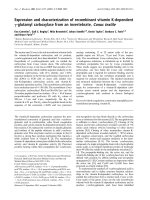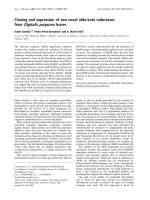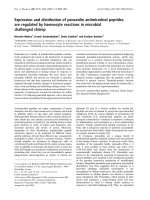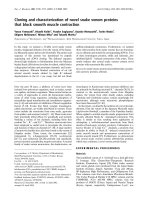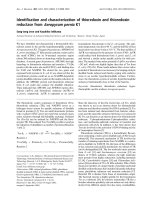Báo cáo y học: "Splendors and miseries of expired CO2 measurement in the suspicion of pulmonary embolism" pdf
Bạn đang xem bản rút gọn của tài liệu. Xem và tải ngay bản đầy đủ của tài liệu tại đây (119.86 KB, 2 trang )
In the previous issue of Critical Care, Rumpf and colleagues
[1] evaluated the potential contribution of measuring
end-tidal carbon dioxide (CO
2
) for suspected pulmonary
embolism (PE) in the prehospital setting. Capnography
has been studied for decades as a potential diagnostic
tool for patients with suspected PE. Indeed, PE is
expected to create areas of reduced arterial fl ow with
normal or increased alveolar ventilation, resulting in
increased alveolar dead space volume and reduced global
expired CO
2
. is should create a diff erence between
arterial and end-tidal CO
2
values, as fi rst demonstrated
by Robin and colleagues [2] in 1959. However, during the
two following decades, several authors pointed out the
numerous pitfalls and sources of errors in assessing the
arterial to end-tidal CO
2
diff erence in the clinical
suspicion of PE, and this test was fi nally abandoned until
the nineties [3-5].
ree elements explain the current resurgence of
expired CO
2
measurement in the suspicion of PE. First,
technical improvements now allow measuring CO
2
not
only for monitoring purposes in intubated patients in
operating rooms but also as a diagnostic tool in
spontaneously breathing patients in the emergency
department or even in the fi eld. Second, volumetric
capnography, which displays expired CO
2
as a function of
the expired volume of the patient, did much to renew
interest in capnography because of its potential for better
performance in diagnosing PE than the arterial to end-
tidal CO
2
diff erence, even though that expectation could
not be confi rmed by recent results [6,7]. Finally, in the era
of non-invasive strategies for PE combining several tests
of various types, such as clinical evaluation, biological
tests, and imaging, the evaluation of a potential role for
CO
2
measurement in combination with those other
instru ments made sense. Numerous studies are available,
and although none to date has been able to prove the
safety of such a non-invasive strategy incorporating
capnography with a high enough level of evidence to
allow its recommendation in daily clinical practice, the
venue remains interesting [7-11].
Where then can we place the endeavor of Rumpf and
colleagues? ey included 131 consecutive patients sus-
pected of PE who had an abnormal rapid point-of-care
D-dimer result in a prehospital setting and evaluated
them with a combination of clinical probability of PE
(two-level Wells score) and measurement of the end-tidal
partial pressure of CO
2
(PCO
2
). PE was diagnosed in the
emergency department by a positive spiral computed
tomography, a high-probability V/Q scan, or a positive
pulmonary angiogram. e combination of a normal
end-tidal CO
2
value (defi ned as higher than 28 mm Hg
based on a receiver operating characteristic analysis) and
an unlikely probability of PE had a 100% sensitivity and
100% negative predictive value (95%confi dence interval
[CI] 90% to 100%) for ruling out PE. In contrast, the asso-
ciation of a low end-tidal CO
2
value (less than 28mmHg)
and a high clinical probability had only an 86% positive
predictive value for PE, and further tests would certainly
Abstract
Capnography has been studied for decades as a
potential diagnostic tool for suspected pulmonary
embolism. Despite technological re nements and its
combination with other non-invasive instruments,
no evidence to date allows recommending the use
of expired carbon dioxide measurement as a rule-out
test for pulmonary embolism without additional
radiological testing. Further investigations are, however,
still warranted.
© 2010 BioMed Central Ltd
Splendors and miseries of expired CO
2
measurement in the suspicion of pulmonary
embolism
Franck Verschuren
1
and Arnaud Perrier
2
*
See related research article by Rumpf et al., />COMMENTARY
*Correspondence:
2
Division of General Internal Medicine, Geneva University Hospital and Faculty of
Medicine, 4, rue Gabrielle-Perret-Gentil, CH-1211 Geneva 14, Switzerland
Full list of author information is available at the end of the article
Verschuren and Perrier Critical Care 2010, 14:110
/>© 2010 BioMed Central Ltd
be required in such patients. Clearly, those results are
preliminary. is is a small series and it was designed to
set the cutoff value for this particular capnography
technique and assess its feasi bility in the fi eld. Moreover,
as acknowledged by the authors themselves, the clinicians
who established the diagnosis were not blinded to either
clinical assessment or capnography results. Finally, the
prevalence of PE is unusually high, although this would
tend to bias the results toward lower, not higher,
sensitivity. But the sheer simplicity of the technique used
by Rumpf and colleagues [1] is appealing and certainly
deserves validation in a large-scale prospective study.
Indeed, it emphasizes the use of expired CO
2
alone
without associated arterial PCO
2
, and this is a pragmatic
issue in modern emergency medicine [12]. Also, the use
of capnography in the prehospital setting is interesting:
there might be situa tions in which a rapid and rough
evaluation of the patient’s expired CO
2
status would help
emergency physicians in making vital decisions, such as
starting thrombolysis for a suspected fulminant PE, as
well as in monitoring the hemodynamic eff ect of
thrombolysis in such patients [13].
Finally, the merit of the article by Rumpf and colleagues
[1] is to remind us that clinical applications of capno-
graphy are still growing, especially amongst spontan-
eously breathing patients. Physicians dealing with acute
medicine should make every eff ort to become familiar
with expired CO
2
measurement. Inconclusive capno-
graphic results related to tachypneic or apprehensive
patients do not overcome the potential for expired CO
2
to be placed inside the diagnostic algorithm of a
challenging disease like PE.
Abbreviations
CO
2
= carbon dioxide; PCO
2
= partial pressure of carbon dioxide; PE =
pulmonary embolism.
Author details
1
Université Catholique de Louvain, Cliniques universitaires Saint-Luc, Acute
Medicine Department, Accidents and Emergency Unit, avenue Hippocrate,
1200 Brussels, Belgium
2
Division of General Internal Medicine, Geneva University Hospital and Faculty
of Medicine, 4, rue Gabrielle-Perret-Gentil, CH-1211 Geneva 14, Switzerland
Competing interests
The authors declare that they have no competing interests.
Published: 27 January 2010
References
1. Rumpf TH, Križmarić M, Grmec S: Capnometry in suspected pulmonary
embolism with positive D-dimer on the eld. Crit Care 2009, 13:R196.
2. Robin ED, Julian DG, Travis DM, Crump CH: A physiological approach to the
diagnosis of acute pulmonary embolism. N Engl J Med 1959, 586-591.
3. Nutter DO, Massumi RA: The arterial-alveolar carbon dioxide tension
gradient in diagnosis of pulmonary embolus. Dis Chest 1966, 50:380-387.
4. Vereerstraeten J, Schoutens A, Tombro M, De Koster: Value of measurement
of alveolo-arterial gradient of PCO2 compared to pulmonary scan in
diagnosis of thromboembolic pulmonary disease. Thorax 1973, 28:306-312.
5. Colp C, Stein M: Re-emergence of an “orphan” test for pulmonary
embolism. Chest 2001, 120:5-6.
6. Patel MM, Rayburn DB, Browning JA, Kline JA: Neural network analysis of the
volumetric capnogram to detect pulmonary embolism. Chest 1999,
116:1325-1332.
7. Verschuren F, Sanchez O, Righini M, Heinonen E, Le Gal G, Meyer G, Perrier A,
Thys F: Volumetric or time-based capnography for excluding pulmonary
embolism in outpatients? J Thromb Haemost 2010, 8:60-67.
8 Kline JA, Israel EG, Michelson EA, O’Neil BJ, Plewa MC, Portelli DC: Diagnostic
accuracy of a bedside D-dimer assay and alveolar dead-space
measurement for rapid exclusion of pulmonary embolism: a multicenter
study. JAMA 2001, 285:761-768.
9. Rodger MA, Jones G, Rasuli P, Raymond F, Djunaedi H, Bredeson CN, Wells PS:
Steady-state end-tidal alveolar dead space fraction and D-dimer: bedside
tests to exclude pulmonary embolism. Chest 2001, 120:115-119.
10. Rodger MA, Bredeson CN, Jones G, Rasuli P, Raymond F, Clement AM,
Karovitch A, Brunette H, Makropoulos D, Reardon M, Stiell I, Nair R, Wells PS:
The bedside investigation of pulmonary embolism diagnosis study:
adouble-blind randomized controlled trial comparing combinations of
3bedside tests vs ventilation-perfusion scan for the initial investigation of
suspected pulmonary embolism. Arch Intern Med 2006, 166:181-187.
11. Sanchez O, Wermert D, Faisy C, Revel MP, Diehl JL, Sors H, Meyer G: Clinical
probability and alveolar dead space measurement for suspected
pulmonary embolism in patients with an abnormal D-dimer test result.
JThromb Haemost 2006, 4:1517-1522.
12. Kline JA, Hogg M: Measurement of expired carbon dioxide, oxygen and
volume in conjunction with pretest probability estimation as a method to
diagnose and exclude pulmonary venous thromboembolism. Clin Physiol
Funct Imaging 2006, 26:212-219.
13. Verschuren F, Heinonen E, Clause D, Roeseler J, Thys F, Meert P, Marion E, El
Gariani A, Col J, Reynaert M, Liistro G: Volumetric capnography as a bedside
monitoring of thrombolysis in major pulmonary embolism. Intensive Care
Med
2004, 30:2129-2132.
Verschuren and Perrier Critical Care 2010, 14:110
/>doi:10.1186/cc8838
Cite this article as: Verschuren F, Perrier A: Splendors and miseries of
expired CO
2
measurement in the suspicion of pulmonary embolism. Critical
Care 2010, 14:110.
Page 2 of 2





